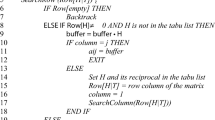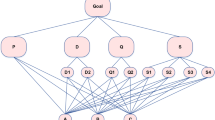Abstract
The aim of the sparse analytic hierarchy process (SAHP) problem is to rank a set of alternatives based on their utility/importance; this task is accomplished by asking human decision-makers to compare selected pairs of alternatives and to specify relative preference information, in the form of ratios of utilities. However, such an information is often affected by subjective biases or inconsistencies. Moreover, there is no general consent on the best approach to accomplish this task, and in the literature several techniques have been proposed. Finally, when more than one decision-maker is involved in the process, there is a need to provide adequate methodologies to aggregate the available information. In this view, the contribution of this paper to the SAHP body of knowledge is twofold. From one side, it develops a novel methodology to aggregate sparse data given by multiple sources of information. From another side, the paper undertakes an experimental validation of the most popular techniques to solve the SAHP problem, discussing the strength points and shortcomings of the different methodology with respect to a real case study.




Similar content being viewed by others
Explore related subjects
Discover the latest articles, news and stories from top researchers in related subjects.References
Achlioptas D, Molloy M, Moore C, Van Bussel F (2005) Rapid mixing for lattice colourings with fewer colours. J Stat Mech Theory Exp 2005(10):P10012
Aczél J, Saaty TL (1983) Procedures for synthesizing ratio judgements. J Math Psychol 27(1):93–102
Alcaraz C, Lopez J (2014) WASAM: A dynamic wide-area situational awareness model for critical domains in smart grids. Future Gener Comput Syst 30:146–154
Barzilai J, Golany B (1994) Ahp rank reversal, normalization and aggregation rules. Inf Syst Oper Res 32(2):57–64
Barzilai J, Cook WD, Golany B (1987) Consistent weights for judgements matrices of the relative importance of alternatives. Oper Res Lett 6(3):131–134
Beg I, Rashid T (2014) Multi-criteria trapezoidal valued intuitionistic fuzzy decision making with Choquet integral based TOPSIS. Opsearch 51(1):98–129
Bessi A, Coletto M, Davidescu GA, Scala A, Caldarelli G, Quattrociocchi W (2015) Science vs conspiracy: collective narratives in the age of misinformation. PLoS ONE 10(2):e0118093
Bozóki S, Tsyganok V (2017) The logarithmic least squares optimality of the geometric mean of weight vectors calculated from all spanning trees for (in) complete pairwise comparison matrices. arXiv preprint arXiv:1701.04265
Carmone FJ, Kara A, Zanakis SH (1997) A monte carlo investigation of incomplete pairwise comparison matrices in AHP. Eur J Oper Res 102(3):538–553
Chen C-T (2000) Extensions of the TOPSIS for group decision-making under fuzzy environment. Fuzzy Sets Syst 114(1):1–9
Chen S-J, Hwang C-L, Hwang FP (2011) Fuzzy multiple attribute decision making (methods and applications). Lecture notes in economics and mathematical systems
Crawford GB (1987) The geometric mean procedure for estimating the scale of a judgement matrix. Math Model 9(3–5):327–334
Davis JM (1958) The transitivity of preferences. Behav Sci 3(1):26–33
Dolan JG, Isselhardt BJ, Cappuccio JD (1989) The analytic hierarchy process in medical decision making: a tutorial. Med Decis Mak 9(1):40–50
Dyer JS (1990) Remarks on the analytic hierarchy process. Manag Sci 36(3):249–258
Dyer M, Greenhill C, Ullrich M (2014) Structure and eigenvalues of heat-bath markov chains. Linear Algebra Appl 454:57–71
Escobar MT, Aguarón J, Moreno-Jiménez JM (2004) A note on AHP group consistency for the row geometric mean priorization procedure. Eur J Oper Res 153(2):318–322
Fax AJ, Murray RM (2004) Information flow and cooperative control of vehicle formations. IEEE Trans Autom Control 49(9):1465–1476
Fedrizzi M, Giove S (2007) Incomplete pairwise comparison and consistency optimization. Eur J Oper Res 183(1):303–313
Forman EH (1990) Multi criteria decision making and the analytic hierarchy process. Springer, Berlin, pp 295–318
Gilks WR, Richardson S, Spiegelhalter D (1995) Markov chain Monte Carlo in practice. CRC Press, London
Häggström O (2002) Finite Markov chains and algorithmic applications, vol 52. Cambridge University Press, Cambridge
Harker PT (1987a) Alternative modes of questioning in the analytic hierarchy process. Math Model 9(3–5):353–360
Harker PT (1987b) Incomplete pairwise comparisons in the analytic hierarchy process. Math Model 9(11):837–848
Hastings KW (1970) Monte carlo sampling methods using markov chains and their applications. Biometrika 57(1):97–109
Hummel JM, IJzermann MJ (2009) The use of the analytic hierarchy process in health care decision making. University of Twente, Enschede
Kendall MG (1938) A new measure of rank correlation. Biometrika 30(1/2):81–93
Liang L, Wang G, Hua Z, Zhang B (2008) Mapping verbal responses to numerical scales in the analytic hierarchy process. Socio-Econ Plan Sci 42(1):46–55
Liberatore MJ, Nydick RL (2008) The analytic hierarchy process in medical and health care decision making: a literature review. Eur J Oper Res 189(1):194–207
Linstone HA, Turoff M et al (1975) The delphi method. Addison-Wesley, Reading
Menci M, Oliva G, Papi M, Setola R, Scala A (2018) A suite of distributed methodologies to solve the sparse analytic hierarchy process problem. In: 2018th European control conference
Metropolis N, Rosenbluth AW, Rosenbluth MN, Teller AH, Teller E (1953) Equation of state calculations by fast computing machines. J Chem Phys 21(6):1087–1092
Olfati-Saber R, Fax JA, Murray RM (2007) Consensus and cooperation in networked multi-agent systems. Proc IEEE 95(1):215–233
Oliva G, Setola R, Scala A (2017) Sparse and distributed analytic hierarchy process. Automatica 85:211–220
Rubio JE, Alcaraz C, Lopez J (2017) Preventing advanced persistent threats in complex control networks. In: European symposium on research in computer security. Springer, pp 402–418
Saaty TL (1977) A scaling method for priorities in hierarchical structures. J Math Psychol 15(3):234–281
Saaty TL (1990) An exposition of the AHP in reply to the paper “remarks on the analytic hierarchy process”. Manag Sci 36(3):259–268
Shiraishi S, Obata T, Daigo M (1998) Properties of a positive reciprocal matrix and their application to AHP. J Oper Res Soc Jpn 41(3):404–414
Van Brummelen G (2012) Heavenly mathematics: the forgotten art of spherical trigonometry. Princeton University Press, Princeton
Author information
Authors and Affiliations
Corresponding author
Ethics declarations
Conflict of interest
All authors declare that they have no conflict of interest.
Ethical approval
All procedures performed in studies involving human participants were in accordance with the ethical standards of the institutional and/or national research committee and with the 1964 Helsinki Declaration and its later amendments or comparable ethical standards.
Informed consent
Informed consent was obtained from all individual participants included in the study.
Additional information
Communicated by P. Beraldi, M. Boccia, C. Sterle.
Publisher's Note
Springer Nature remains neutral with regard to jurisdictional claims in published maps and institutional affiliations.
Rights and permissions
About this article
Cite this article
Oliva, G., Setola, R., Scala, A. et al. Sparse analytic hierarchy process: an experimental analysis. Soft Comput 23, 2887–2898 (2019). https://doi.org/10.1007/s00500-018-3401-9
Published:
Issue Date:
DOI: https://doi.org/10.1007/s00500-018-3401-9




